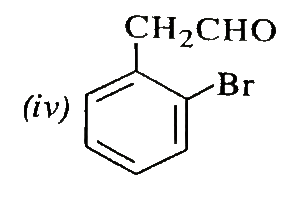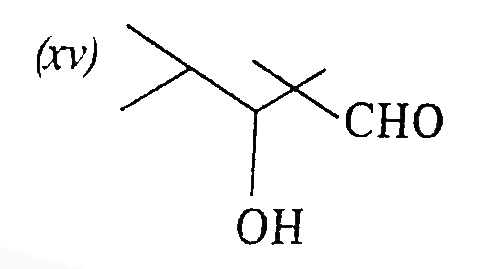C3H6Cl2A(i) KCN−−−−−−→(ii) H3O+(iii) ΔCH3CH| CH3COOH. Hence, A is
1, 1-dichloro propane
1, 2-dichloro propane
2,2-dichloro propane
1, 3-dichloro propane
The correct Answer is:C
End product indicates that A has (CH3)2CH group.
Thus, A is (CH3)2CHCl2
(CH3)2CHCl2KCN−−→(CH3)2CH(CN)2H3O+−−−→(CH3)2CH(COOH)2Δ−−→(CH3)2CHCOOH
when two −COOH groups are present on the same carbon then on heating elimintes CO2.
Topper's Solved these Questions
- ALKYL HALIDEBook:MHTCET PREVIOUS YEAR PAPERS AND PRACTICE PAPERSChapter:ALKYL HALIDEExercise:MHT CET Corner
Explore 25 Videos
- ALKYL HALIDEBook:MHTCET PREVIOUS YEAR PAPERS AND PRACTICE PAPERSChapter:ALKYL HALIDEExercise:PRACTICE EXERCISE (Exercise 1 (TOPICAL PROBLEMS))
Explore 80 Videos
- ALKANESBook:MHTCET PREVIOUS YEAR PAPERS AND PRACTICE PAPERSChapter:ALKANESExercise:EXERCISE 2
Explore 20 Videos
- BASIC PRINCIPLES AND TECHNIQUES IN ORGANIC CHEMISTRYBook:MHTCET PREVIOUS YEAR PAPERS AND PRACTICE PAPERSChapter:BASIC PRINCIPLES AND TECHNIQUES IN ORGANIC CHEMISTRYExercise:EXERCISE 2
Explore 20 Videos
Similar Questions
Write IUPAC names of the following compounds :
((i) CH3−CH| CH3−CH| OH−CH3| C | CH3−CH3
(ii) CH3−CH| OH−CH2−CH| OH−CH| C2H5−CH2CH3
(iii) CH3−CH| OH−CH| OH−CH3
(iv) HO−CH2−CH| OH−CH2−OH

(ix) CH3−O−CH2−CH| CH3−CH3
(x) C6H5−O−C2H5
(xi) C6H5−O−C7H15(n−)
(xii) CH3−CH2−O−CH| CH3−CH2−CH3
View SolutionName the following compounds accoring to IUPAC system :
(i) CH3−CH2−CH∣CH2Cl−CH2OH∣CH−CH∣CH3−CH3(ii)CH3−CH∣CH3−CH2−CH∣OH−CH2OH∣CH−CH3
(iii) (iv) H2C=CH−CH∣OH−CH2−CH2−CH3
(iv) H2C=CH−CH∣OH−CH2−CH2−CH3
(v) CH3−C∣CH3=C∣Br−CH2OH
View Solution
Knowledge Check
Consider the following conversions :
I. CH3CHCHO∣CNH3O+−−−→CH3CH3CHCHO∣COOH
II. CH3CHCN∣OHH3O+−−−→CH3CHCOOH∣OH
III. O∣∣CH3CCNH3O+−−−→O∣∣CH3CCOOH
In which case(s), preference group of nomenclature changes ?AIBI, IICI, II, IIIDI, IIIThe conversation :
CH3−CH3∣C∣OH−CH3∣C∣OH−CH3dil−−−→H2SO4CH3−CH3∣C∣CH3−C∣∣O−CH3
is called :ABeckmann rearrangement.BPinacol-Pinacolone rearrangementCClaisen rearrangementDFries rerragement.In the following reaction, three product a, b, c are obtained.
H3C−CH3| C | CH3−CH| OH−CH3H3PO4/heat−−−−−−−→H3−C−CH2| C | CH3−CH (a)=CH2+ +H3C−CH2||C−CH| CH2−CH3(c) A(a)33%,(b)64%,(c)3%B(a)3%,(b)64%,(c)33%C(a)3%,(b)33%,(c)64%D(a)64%,(b)3%,(c)33%
+H3C−CH2||C−CH| CH2−CH3(c) A(a)33%,(b)64%,(c)3%B(a)3%,(b)64%,(c)33%C(a)3%,(b)33%,(c)64%D(a)64%,(b)3%,(c)33%
(A) What is the final product in each reaction?
(i)C2H5OHI2−−−−−−→NaOH
(ii)CHCI3Ag−−−−−→Heat?
(iii)CHCI3HNO3−−−→?
(iv)CI4Fe/H2O−−−−→?
(v)C6H5NH2CHCI3−−−−−→KOH?
(vi)C4H9BrNaNO2/C2H5OH−−−−−−−−−−→?

(ix)CH3LiCH2=CH2−−−−−−→?
(x)(CH3)3CCI(CH3)2Zn−−−−−−→?
(xi)H2C=CH3∣C−CH2CH3IBr−−→?
(xii)CH3−CH−CH2NBS−−→?
(xiii)CH3−C∣CH3H−CH2CINaI−−−−−−−−−→Acetone,Δ?
(xiv)R3MgX(CH3)2CO/H2O−−−−−−−−−−→?
(xv)CH3−C∣BrH−C∣CH3H−CH3+HBr→?
(xvi)CH3−C∣CH3H−C∣OHH−CH3+HBr→?

(xx)CH3−CH3∣C∣CH3−C∣CIH−CH3+KOH(alc)→?
(xxi)(CH3)3C−CH2Br+KOH(alc)→?
(xxii)CH3−CH3∣C∣CH3−CH2Br+C2H5OHHeat−−→?

(B)(i)C6H5CH2CH3Br2−−−−−→hv?
(ii)C6H5CH2CH3(i)Br2,heat ,light−−−−−−−−−−−−−−→(ii)NaCN,H2O/H?
(iii)CICH2CH2CH2COPhKOH−−−−−−→MeOH?


View SolutionWrite the IUPAC names of :
(i) CH3CH2CH2C∣CH3HCH2CHO
(ii) CH3COCC2H5HCH2CH2Cl
(iii)
(iv)
(v) CH3−C∣CH3H−O∣∣C−C∣CH3H−OC2H5
(vi) CH3−C∣CH3H−CO−C∣CH3H−CH3
(vii) CH3−C∣C6H5H−O∣∣C−C∣CH3HOCH2CH3
(viii) CH3−C∣CH3H−O∣∣C−C∣CH3H−Br
(ix) OCH.CHO
(x)
(xi) CH3−C∣NH2H−C∣OHH−C∣∣O−C2H5
(xii) CH3−CH2−CH∣CH3−CH2CHO
(xiii)
(xiv) CH3−C∣CH3H−CH2−CH2−C∣∣O−CH2Cl
(xv)
(xvi) CH3−CH2−CH=CH−O∣∣C−H
View SolutionWrite IUPAC names of the following compounds :
(i) CH3−CH∣CH3−CH2−CH∣OH−CH3∣C∣CH3−CH3 (ii) H3−C−CH∣OH−CH2−CH∣OH−CH∣C2H5−CH2−CH3
CH3−CH∣OH−CH∣OH−CH3
(iv) HO−CH2−CH∣OH−CH2−OH

View SolutionArrange the following compound in order decreasing reactivity in the E2 reaction:
(i) H3C−CH3∣C∣CH3−Br
(ii) D3C−CD3∣C∣CD3−Cl
(iii) H3C−CH3∣C∣CH3−Cl
(iv) H3C−CH3∣C∣CH3−l
View Solution2-chloro-2-methylpentane on reaction with sodium methoxide in methanol yields:
(a) C2H5CH2CH3∣C∣CH3−OCH3 (b) C2H5CH2C∣CH3=CH2 (c) C2H5CH2=C∣CH3−CH3
View Solution

